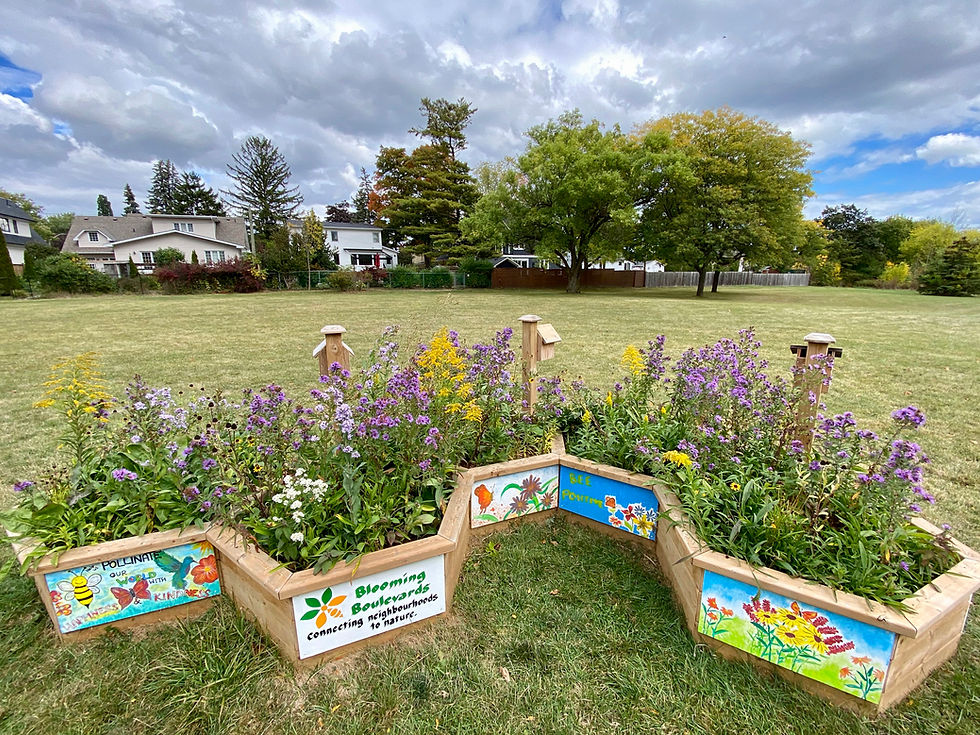What happened to my black-eyed Susans?
- Jeanne McRight

- Jul 9, 2021
- 3 min read
Second year boulevard garden steward challenges
by Sheila Cressman
You nurtured the little seedlings you received from Blooming Boulevards and watched them turn into strong plants by the end of the season. Now, you’re a boulevard veteran, and some issues have arisen. Here are some frequent questions from our second and third year garden stewards, with advice from our President, Jeanne McRight.
Q: What happened to my Black eyed Susans? They flourished for 2 years and now they’ve disappeared.
A: Black eyed Susans (BES) are a short lived successional plant. Adults are usually biennial and often do not live beyond 2 years. They self-perpetuate by sprinkling their seeds around. Your first step is to check to see if there are any seedlings in evidence. Some people have a tendency to over weed their gardens early in the season. If you do so you may be pulling out your BES seedlings or other native plants which have seeded over the fall and winter. Have there been harsh conditions such as the lengthy dry period we experienced this spring which have stopped germination? During a spring drought when seeds are germinating, make sure you keep the soil moist. Be careful that there isn’t too much mulch surrounding existing plants which may prevent seedlings from contacting the soil.
Above: Black-eyed Susan seedlings are fuzzy and leaves feel a bit rough. More mature second year garden has fewer BES than garden in first year since self-sown seedlings need time to grow and flower.
Q: Can I buy BES plants or seeds from a nursery to supplement what’s survived on my boulevard?
A: It may not be wise to mix nursery grown plant material with the natives grown by Blooming Boulevards. We obtain our seeds from local restoration sites which result in tough mother plants which have the best chance for survival. Plants from large commercial nurseries are greenhouse or field cultivated. Such plants have been pampered as they haven’t lived in natural conditions. They may be cloned rather than grown from seed. The risk is that nursery grown plants could cross breed with native plant stock and weaken the genome.
Q: Last year I planted grasses which have now taken over a large portion of my garden, choking out other plants. How can I prevent this from happening in the future?
A: It should be pretty easy to pull out the unwanted grasses to free the plants that you’re nurturing in that area. Maturing seed heads from the remaining grasses can be cut off before they fall to the ground. As the garden fills in with herbaceous plants the grasses will be shaded out, with less opportunity to overwhelm other plants. Seed heads can also be cut off from other plants that are a risk to taking over your garden.
Q: How do I keep the evening primrose, asters and stiff goldenrod to an acceptable height?
A: Use the Chelsea chop to reduce their size and extend the blooming season. Instructions can be found here. Do not use this method for flowers with hollow stems, such as foxglove beardtongue, as water will get in and cause the crown to rot.
Q: I would like to plant low ground cover along the border of my boulevard. Could you please suggest some suitable native plants which will not infringe on the sidewalk?
A: Low (under 45 cm) native and pollinator-friendly non-native perennial species that are easy-to-manage ground covers and edging for sunny borders in pollinator gardens include:
Wild strawberries Fragaria virginiana - see photo below

Blue-eyed grass Sisyrinchium montanum
Harebell Campanula rotundifolia
Prairie smoke Geum triflorum
Nodding onion Allium cernuum
Pussytoes Antennaria neglecta
Sedum spp. (non-native)
Thymus spp. (non-native)
Creeping germander Teucrium Chamaedrys (non-native)
Lavendula spp. (non-native)
Q: Rabbit attack! How do I keep my plants safe?
A: Rabbits tend to go after young tender plants and do not like the more mature fibrous plants. The simplest approach is to use an animal deterrent spray such as Bobbex or Plant Skydd. If you prefer something milder smelling you could try Animal be Gone, however its effects are not as long lasting. Mints and aromatic species (this includes Monarda spp, dotted mint and anise hyssop) are less attractive to rabbits. You could use such plants to surround those that the rabbits are more likely to graze on.
Q: My Monarda are covered with powdery mildew! How can I rescue them?
A: Monarda spp. such as bee balm and wild bergamot are prone to this issue, especially when they’re packed together with insufficient ventilation. Powdery mildrew will be disfiguring but it’s not fatal. Thin the patch to ensure they have lots of access to air. Home remedies include spraying leaves with a bicarbonate of soda solution or milk. Read more about powdery mildew on Monarda here>>
Q: I’ve noticed aphids on my swamp milkweed and butterfly milkweed. What’s the best way to keep them under control?
A: Do not spray the aphids with an insecticide. Non toxic suggestions for dealing with aphids can be found in our fall 2020 newsletter article Dealing With Milkweed Aphids by Murray Moore.

















Comments